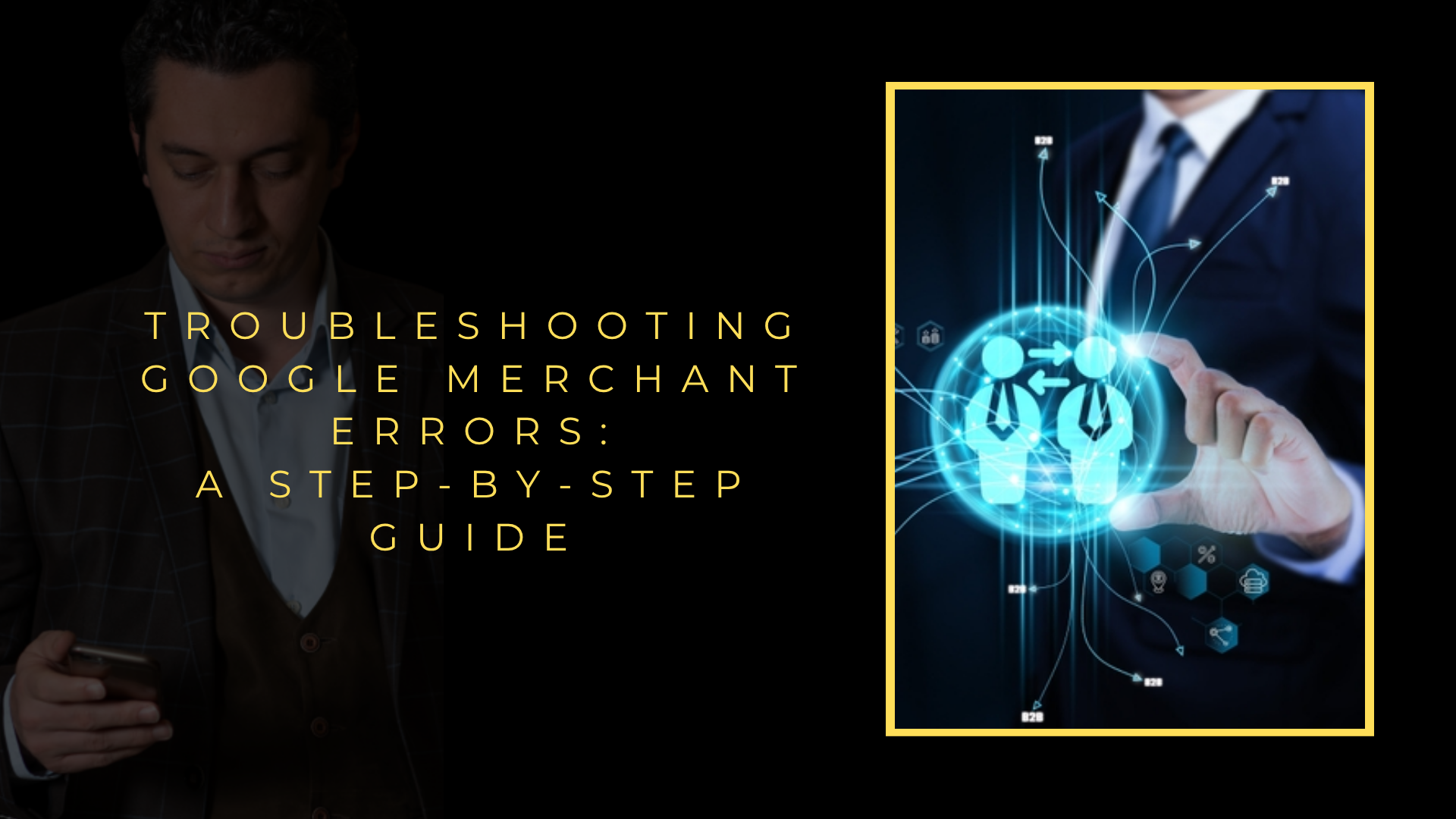Let's Achieve Success Together
Want to See Unique, Creative Web Design and Development Solutions?
Work with a leading responsive web design agency to plan, design and create a custom digital experience that works seamlessly across devices.


For industrial engineers and product managers, the Google Merchant Center represents a critical supply chain node for digital product distribution. When errors arise, they directly impede the flow of goods to market, causing significant ROI erosion. A systematic guide to resolving these issues is not a luxury but a fundamental component of operational efficiency.
A comprehensive troubleshooting guide functions as a decision support system, enabling teams to quickly diagnose and rectify feed errors. This proactive approach minimizes downtime and ensures product listings remain active and competitive. The immediate application is in preventing lost sales and maintaining brand integrity across Google's vast network.
Common errors often relate to data quality, such as missing or inconsistent product attributes that halt the approval process. A detailed guide provides clear remediation steps, transforming a chaotic debugging exercise into a streamlined, repeatable procedure. This is essential for maintaining a clean and compliant product data feed.
From a technical perspective, resolving issues like schema markup inaccuracies or image policy violations requires precise knowledge. The guide serves as a technical manual, empowering engineers to implement correct structured data and adhere to specifications, thereby enhancing the product's visibility and click-through rate.
For commercial leaders, the guide translates technical fixes into tangible business outcomes. By ensuring a higher volume of products are eligible for premier ad placements, the company can achieve superior market share and outmaneuver competitors. The methodology presented by Serdar Gürsoy emphasizes a data-driven approach to e-commerce management.
Ultimately, mastering Google Merchant Center troubleshooting is a strategic competitive advantage. It ensures that marketing investments yield maximum returns and that the digital shelf presence is robust. This systematic approach to error resolution is a cornerstone of modern commercial excellence.
For industrial engineers and product managers, Google Merchant Center errors represent more than simple technical notifications; they are critical data integrity signals that directly impact supply chain visibility and revenue streams.
Each violation, such as an "invalid price" or "missing identifier," flags a breakdown in the data synchronization between a company's Product Information Management (PIM) system and Google's required feed specifications.
Interpreting these errors requires understanding their taxonomy: account-level disapprovals halt all traffic, while item-level issues require pinpoint diagnostic analysis of specific SKUs.
A systematic troubleshooting workflow is essential, beginning with identifying the root cause within the source data, such as an incorrect GTIN mapping or an outdated image URL.
Engineers must implement robust automated validation protocols within data export processes to pre-emptively catch discrepancies before they reach the feed submission stage.
For commercial leaders, the resolution of these errors is a direct performance optimization activity, as approved products gain eligibility for high-value surfaces like Shopping ads and organic listings.
A clean product feed enhances attribute accuracy, which improves match rates with user queries and increases the likelihood of conversion, directly affecting return on advertising spend.
Proactive feed management, as detailed by Serdar Gürsoy, transforms a reactive error-resolution task into a strategic competitive advantage, ensuring product data acts as a reliable asset.
Ultimately, mastering Google Merchant errors is not about compliance alone but about achieving superior digital shelf presence in a crowded online marketplace.
In the industrial and environmental sectors, where product specifications are complex and compliance is non-negotiable, a systematic troubleshooting approach to Google Merchant Center disapprovals is a critical commercial capability. The process begins with a rigorous data quality audit of the product feed, focusing on the precise attributes that trigger algorithmic flags. For industrial equipment, common issues include inaccurate GTIN assignment for custom parts or insufficient technical data in the title and description fields.
A structured resolution protocol, as detailed by Serdar Gürsoy, prioritizes diagnosing the specific disapproval reason provided within the Merchant Center interface. This initial diagnosis prevents wasted effort on irrelevant fixes. The next phase involves implementing a feed optimization strategy, which often requires enriching product data with detailed material specifications, safety certifications, or energy efficiency ratings to meet both platform policies and industrial buyer expectations.
The technical workflow must incorporate a robust version control system for the product data feed. This allows product managers to roll back problematic updates and maintain a clear history of changes, which is essential for auditing and continuous improvement. For large-scale industrial catalogs, automation through scripts or middleware is necessary to efficiently correct errors across thousands of SKU entries.
Effective resolution directly impacts key performance indicators by restoring product visibility and click-through rates. A disciplined approach minimizes the time-to-market for new products and ensures that high-value capital equipment remains eligible for performance max campaigns. This process transforms a reactive support task into a proactive competitive advantage, ensuring that complex industrial products are accurately represented and discoverable within the digital marketplace.
Ultimately, mastering this step-by-step process is not merely about compliance; it is about leveraging the Google Merchant Center as a precise technical channel for commercial growth. The methodology provides a framework for maintaining data integrity, which builds trust with a professional audience and directly supports revenue generation in highly specialized markets.

The integrity of a product data feed is the foundational pillar for successful Google Shopping campaigns, directly impacting product visibility and revenue streams. For industrial and commercial entities, a malfunctioning feed represents a critical operational bottleneck, halting the flow of products to a primary digital marketplace. A technical guide authored by Serdar Gürsoy provides a systematic framework for diagnosing these disruptions, transforming a reactive troubleshooting process into a proactive data quality management protocol.
Such a guide delves into the technical specifics of common errors, such as invalid GTIN codes or mismatched attribute values, which are frequent pain points for complex industrial product lines. It emphasizes the importance of feed optimization beyond mere error correction, focusing on enhancing data richness to improve ad rank and qualify for premium shopping placements. The methodology involves a detailed analysis of feed specifications, ensuring each product entry meets Google's stringent requirements for completeness and accuracy.
Implementing the diagnostic procedures outlined in the guide enables product managers to establish a robust data governance strategy. This systematic approach minimizes disapprovals and maximizes the return on advertising spend by ensuring a larger portion of the product catalog is actively competing in auctions. The technical insights facilitate a deeper understanding of how attribute mapping from internal ERP or PIM systems to the required feed schema must be meticulously managed to prevent data corruption.
For commercial decision-makers, the value proposition is clear: a technically sound feed is a direct revenue driver. The guide provides the necessary toolkit to audit, validate, and enhance product data, leading to improved click-through rates and lower customer acquisition costs. By adopting the prescribed technical workflow automation for feed maintenance, organizations can achieve scalable and sustainable e-commerce performance, turning a potential vulnerability into a competitive advantage.
The suspension of a Google Merchant Center account represents a critical operational failure with immediate financial repercussions, halting product visibility across Google's vast search network and derailing essential revenue streams.
Common causes for suspension often stem from fundamental data quality issues within the product feed, where discrepancies between advertised prices, availability, or shipping details and the actual landing page experience violate Google's strict policy compliance standards.
Proactive prevention is a function of robust technical infrastructure, requiring automated systems for continuous feed validation and monitoring to ensure all product data attributes align perfectly with the live website, a process integral to maintaining account health.
Implementing a rigorous quality assurance protocol before submitting feed updates is a strategic commercial imperative, as it minimizes the risk of introducing errors that could trigger a manual or algorithmic review.
When a suspension occurs, the path to reinstatement demands a meticulous audit of the entire product catalog to identify and rectify every policy violation, a time-consuming process where expertise is paramount.
A successful appeal hinges on a comprehensive diagnostic analysis that not only corrects the immediate errors but also addresses the underlying systemic gaps in data management that led to the initial suspension.
For industrial suppliers and complex product manufacturers, maintaining data integrity across thousands of SKUs with technical specifications is a significant challenge, making specialized knowledge in feed management essential.
Expert guidance from professionals like Serdar Gürsoy can streamline the reinstatement process by providing a clear, evidence-based action plan that communicates effectively with Google's support teams, thereby accelerating the restoration of advertising capabilities.
Ultimately, treating the Merchant Center as a core component of the digital supply chain, with the same level of scrutiny as physical logistics, ensures sustained compliance and maximizes the return on advertising spend.
For industrial engineers and product managers, the Google Merchant Center represents a critical data feed conduit, yet recurring errors can severely disrupt supply chain visibility and commercial performance. A systematic approach to error resolution transforms this operational bottleneck into a competitive advantage. The foundation of a permanent fix lies in mastering feed specifications, which dictate the precise structure and attribute requirements for product data.
Common errors like "Invalid GTIN" or "Missing Identifier [gtin]" are not mere technical glitches but symptoms of a flawed data pipeline. Permanently resolving these requires implementing automated validation checks at the point of data entry, often within the Product Information Management (PIM) system. This preemptive data validation ensures that all product identifiers are correct and formatted according to global standards before they ever reach the feed.
Issues related to "Price Mismatch" or "Availability Discrepancy" directly impact customer trust and inventory turnover. A permanent solution necessitates a real-time synchronization protocol between the enterprise resource planning (ERP) system and the Google Merchant Center. This integration creates a single source of truth, eliminating manual updates and ensuring pricing and stock levels are always accurate across all sales channels.
For complex industrial product lines, errors such as "Image Link Requirements" can halt campaigns. Addressing this requires a robust digital asset management strategy, where high-resolution images, technical diagrams, and compliance certificates are stored, tagged, and served via secure, crawlable URLs that comply with Google's technical requirements.
Ultimately, achieving a consistently error-free feed is a matter of process engineering. By treating the product feed as a key component of the digital shelf, organizations can enforce quality assurance standards that mirror those used in physical manufacturing. This operational discipline, as advocated by experts like Serdar Gürsoy, minimizes wasted ad spend and maximizes the return on digital marketing investment.
The commercial benefit of this technical rigor is a significant enhancement in product visibility. A clean, optimized data feed improves ranking within Google Shopping results, driving qualified traffic from engineers and procurement specialists actively searching for industrial solutions. This direct link between data integrity and commercial outcome underscores the strategic importance of mastering feed management.
Contents


Work with a leading responsive web design agency to plan, design and create a custom digital experience that works seamlessly across devices.
Contact Form
Fill out the form and we will contact you as quickly as possible.
Whatsapp'tan Bize Ulaşın.
Bir konuşma başlatmak için kamera uygulamanızla tarayın veya QR kodunu tıklayın.
Lorem Ipsum, dizgi ve baskı endüstrisinde kullanılan mıgır metinlerdir. Lorem Ipsum, adı bilinmeyen bir matbaacının bir hurufat numune kitabı oluşturmak üzere bir yazı galerisini alarak karıştırdığı 1500'lerden beri endüstri standardı sahte metinler olarak kullanılmıştır. Beşyüz yıl boyunca varlığını sürdürmekle kalmamış, aynı zamanda pek değişmeden elektronik dizgiye de sıçramıştır. 1960'larda Lorem Ipsum pasajları da içeren Letraset yapraklarının yayınlanması ile ve yakın zamanda Aldus PageMaker gibi Lorem Ipsum sürümleri içeren masaüstü yayıncılık yazılımları ile popüler olmuştur.
Yinelenen bir sayfa içeriğinin okuyucunun dikkatini dağıttığı bilinen bir gerçektir. Lorem Ipsum kullanmanın amacı, sürekli 'buraya metin gelecek, buraya metin gelecek' yazmaya kıyasla daha dengeli bir harf dağılımı sağlayarak okunurluğu artırmasıdır. Şu anda birçok masaüstü yayıncılık paketi ve web sayfa düzenleyicisi, varsayılan mıgır metinler olarak Lorem Ipsum kullanmaktadır. Ayrıca arama motorlarında 'lorem ipsum' anahtar sözcükleri ile arama yapıldığında henüz tasarım aşamasında olan çok sayıda site listelenir. Yıllar içinde, bazen kazara, bazen bilinçli olarak (örneğin mizah katılarak), çeşitli sürümleri geliştirilmiştir.
Yaygın inancın tersine, Lorem Ipsum rastgele sözcüklerden oluşmaz. Kökleri M.Ö. 45 tarihinden bu yana klasik Latin edebiyatına kadar uzanan 2000 yıllık bir geçmişi vardır. Virginia'daki Hampden-Sydney College'dan Latince profesörü Richard McClintock, bir Lorem Ipsum pasajında geçen ve anlaşılması en güç sözcüklerden biri olan 'consectetur' sözcüğünün klasik edebiyattaki örneklerini incelediğinde kesin bir kaynağa ulaşmıştır. Lorm Ipsum, Çiçero tarafından M.Ö. 45 tarihinde kaleme alınan "de Finibus Bonorum et Malorum" (İyi ve Kötünün Uç Sınırları) eserinin 1.10.32 ve 1.10.33 sayılı bölümlerinden gelmektedir. Bu kitap, ahlak kuramı üzerine bir tezdir ve Rönesans döneminde çok popüler olmuştur. Lorem Ipsum pasajının ilk satırı olan "Lorem ipsum dolor sit amet" 1.10.32 sayılı bölümdeki bir satırdan gelmektedir.
1500'lerden beri kullanılmakta olan standard Lorem Ipsum metinleri ilgilenenler için yeniden üretilmiştir. Çiçero tarafından yazılan 1.10.32 ve 1.10.33 bölümleri de 1914 H. Rackham çevirisinden alınan İngilizce sürümleri eşliğinde özgün biçiminden yeniden üretilmiştir.
Lorem Ipsum pasajlarının birçok çeşitlemesi vardır. Ancak bunların büyük bir çoğunluğu mizah katılarak veya rastgele sözcükler eklenerek değiştirilmişlerdir. Eğer bir Lorem Ipsum pasajı kullanacaksanız, metin aralarına utandırıcı sözcükler gizlenmediğinden emin olmanız gerekir. İnternet'teki tüm Lorem Ipsum üreteçleri önceden belirlenmiş metin bloklarını yineler. Bu da, bu üreteci İnternet üzerindeki gerçek Lorem Ipsum üreteci yapar. Bu üreteç, 200'den fazla Latince sözcük ve onlara ait cümle yapılarını içeren bir sözlük kullanır. Bu nedenle, üretilen Lorem Ipsum metinleri yinelemelerden, mizahtan ve karakteristik olmayan sözcüklerden uzaktır.
 Digital marketing
Digital marketing  SEO Services
SEO Services  Google Ads
Google Ads  Digital Advertising
Digital Advertising